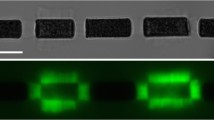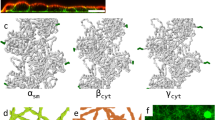Summary
F-actin was electrophoresed in capillary tubes filled with agarose gel. The use of capillary imparted high resistance on the gel allowing the use of high enough concentration of salts to keep F-actin polymerized, and allowed the application of high electric fields without liberating considerable amount of heat. The intensity profile of the electrophoretic band of F-actin showed a peak, which in 1% agarose in the electric field of 17.8 V cm−1 at 0° C, migrated at 3.4 cm hr−1. Microscopic observation of actin filaments extracted from different positions along the gel showed that during electrophoresis filaments distributed themselves in such a manner that the longest polymers migrated slowest and the shortest migrated fastest. Using this observation we calculated the weight and number distributions of filament lengths from corresponding experimental intensity profiles. Phalloidin-labelled F-actin oriented in the gel upon application of an electric field. F-actin showed unusual orientational response: it oriented rapidly when the field was applied, but relaxed very slowly when the field was removed. Orientation of F-actin varied within an electrophoretic band, longest polymers showing the best orientation and short oligomers and monomers not orienting at all. The degree of orientation increased with the size of the electric field. When F-actin was labelled with phalloidin before electrophoresis, it was no longer able to migrate in the gel, but the electric field oriented it in the same way as when it was labelled after the electrophoresis. These results show that the electrophoresis of F-actin in agarose fractionates it according to its length, that by using electrophoresis it is possible to rapidly obtain distribution of filament lengths, and that F-actin migrates in agarose by the process of reptation.
Similar content being viewed by others
References
Borejdo, J. (1989) Orientation of DNA in agarose gels.Biophys. J. 55, 1183–90.
Borejdo, J. &Burghardt, T. P. (1987) Cross-bridge order and orientation in resting and active muscle fibers.Optical Studies of Muscle Cross-bridges (edited by Baskin, R. J. & Yeh, Y.) pp. 100–21, Florida: CRC Press Inc.
Borejdo, J. &Ortega, H. (1989) Electrophoresis and orientation of F-actin in agarose gels.Biophys. J. 56, 285–93.
Borejdo, J., Assulin, O., Ando, T. &Putnam, S. (1982) Crossbridge orientation in skeletal muscle measured by linear dichroism of an extrinsic chromophore.J. Mol. Biol. 158, 391–414.
Bryan, J. K. (1977) Molecular weights of protein multimers from polyacrylamide gel electrophoresis.Anal. Biochem. 78, 513–9.
Burghardt, T. P. &Ajtai, K. (1989) Effect of negative mechanical stress on the orientation of myosin cross-bridges in muscle fibers.Proc. Natl Acad. Sci. 86, 5366–70.
Chrambach, A. &Rodbard, D. (1971) Polyacrylamide gel electrophoresis.Science 172, 440–51.
Crowder, M. S. &Cooke, R. (1987) Orientation of spin-labelled nucleotides bound to myosin in glycerinated muscle fibers.Biophys. J. 51, 323–33.
Dos Remedios, C. G., Millikan, R. G. C. &Morales, M. F. (1972) Polarization of tryptophan fluorescence from single striated muscle fibers.J. Gen. Physiol. 59, 103–20.
Goldman, Y. E., Hibberd, M. G. &Trentham, D. R. (1984) Initiation of active contraction by photogeneration of adenosine-5′-trisphosphate in rabbit psoas muscle fibers.J. Physiol. 354, 605–24.
Hartwig, J. H. &Stossel, T. P. (1979) Cytochalasin B and structure of actin gels.J. Mol. Biol. 134, 539–53.
Hibberd, M. G., Dantzig, J. A., Trentham, D. R. &Goldman, Y. E. (1985) Phosphate release and force generation in skeletal muscle.Science 228, 1317–9.
Holzwarth, G., McKee, C. B., Steiger, S. &Crater, G. (1987) Transient orientation of linear DNA molecules during DNA electrophoresis.Nucl. Acid Res. 15, 10031–44.
Janmey, P. A., Peetermans, J., Zaner, K. S., Stossel, T. P. &Tanaka, T. (1986) Structure and mobility of actin filaments as measured by quasielastic light scattering, viscometry and electron microscopy.J. Biol. Chem. 18, 8357–62.
Jenkins, F. A. &White, H. E. (1957)Fundamental of Optics, pp. 524–31. New York: McGraw-Hill Inc.
Karger, B. L., Cohen, A. S. &Guttman, A. (1989) High-performance capillary electrophoresis in the biological sciences.J. Chromatography 492, 585–614.
Kawamura, M. &Maruyama, K. (1970) Electron microscopic particle length of F-actin polymerized in vitro.J. Biochem. 67, 437–57.
Kawamura, M. &Maruyama, K. (1972) A further study of electron microscopic particle length of F-actin polymerized in vitro.J. Biochem. 72, 179–88.
Koch, M. H., Dorrington, E., Klaring, R., Michon, A. M., Sayers, Z., Marquet, R. &Houssier, C. (1988) Electric field X-ray scattering measurements on tobacco mosaic virus.Science 240, 194–6.
Lumpkin, O. J., Dejardin, P. &Zimm, B. H. (1985) Theory of gel electrophoresis of DNA.Biopolymers 24, 1573–93.
Miki, M. &Mihashi, K. (1977) Fluorescence and flow dichroism of F-actin-ADP; the orientation of the adenine plane relative to the long axis of F-actin.Biophys. Chem. 6, 101–6.
Nunnally, M. H., Powell, L. D. &Craig, S. W. Reconstitution and regulation of actin gel-sol transformation with purified filamin and villin.J. Biol. Chem. 256, 2083–6.
Oosawa, F. (1970) Size distribution of actin polymers.J. Theor. Biol. 27, 69–86.
Popp, D., Lednev, V. V. &Jahn, W. (1987) Methods of preparing well-orientated sols of F-actin containing filaments suitable for X-ray diffraction.J. Mol. Biol. 197, 679–84.
Southern, E. M. (1979). Measurement of DNA length by gel electrophoresis.Anal. Biochem 100, 319–23.
Spudich, J. A. &Watts, S. (1971) Regulation of rabbit muscle contraction.J. Biol Chem. 246, 4866–71.
Stellwagen, J. &Stellwagen, N. C. (1989) Orientation of the agarose gel matrix in pulsed electric fields.Nucleic Acid Res. 17, 1537–48.
Tanford, C. (1961)Physical Chemistry of Macromolecules pp. 143. New York: John Wiley.
Taylor, E. W. (1979) Mechanism of actomyosin ATPase and the problem of muscle contraction.CRC Crit. Rev. Biochem. 6, 103–64.
Torbet, J. &Dickens, M. J. (1984) Orientation of skeletal muscle actin in strong magnetic fields.FEBS Letts 173, 403–6.
Weber, G. (1966)Fluorescence and Phosphorescence Analysis (edited by Hercules, D. M.) pp. 217–40. New York: Interscience.
Wulf, E., Deboben, E., Bautz, F. A., Faulstich, H. &Wieland, Th. (1979) Fluorescent phallotoxin, a tool for the visualization of cellular actin.Proc. Natl Acad. Sci. 9, 4498–502.
Yin, H. L., Zaner, K. S. &Stossel, T. P. (1980) Ca2+ control of actin gelation.J. Biol. Chem. 255, 9494–500.
Author information
Authors and Affiliations
Rights and permissions
About this article
Cite this article
Borejdo, J., Burlacu, S. Distribution of actin filament lengths and their orientation measured by gel electrophoresis in capillaries. J Muscle Res Cell Motil 12, 394–407 (1991). https://doi.org/10.1007/BF01738594
Received:
Accepted:
Issue Date:
DOI: https://doi.org/10.1007/BF01738594




